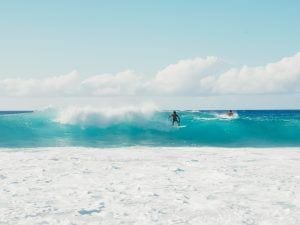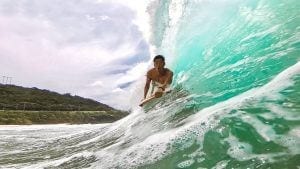Words to keep in mind when trying to decide whether or not to surf a wave; “If in doubt, don’t go out.”
Beginner
–Castles/Malaekahana Beach:
Family friendly beach that offers beginner waves for all ages or intermediate surfs looking for a fun day with friends. There are multiple wave breaks and it’s a short paddle from the beach. Just keep in mind there can be a lot of people and surf schools here making it a crowded place.
–Pua’ena Point:
There are multiple sections to these waves, allowing for multiple surfers to enjoy a long ride on smooth sloped wave. It caters to both the shortboarders and long board riders. This spot can be one of the most crowded places in regard to surf schools.
–Kawela bay:
This spot is located West of Turtle Bay and is protected from the giant waves that batter the North Shore in winter months. The shape of Kawela Bay, and the reef, diffuses the power and intensity of the swells making it an ideal spot for small rolling waves; perfect for beginners to enjoy. What is amazing about Kawela Bay is that it is one of the most protected coast lines along the North Shore and tucked away from the road keeping it less crowded. The bay offers quiet and serene beaches that the whole family can enjoy, even if they’re not surfing. However, there are a lot of rocks on the bottom and water can be murky so be careful when snorkeling and swimming.
Intermediate
Note: Although these waves offer amazing rides the conditions may change and can be dangerous to battle. Always consult with the local lifeguards if you’re unsure.
–Turtle Bay*:
Conditions vary but usually remain the same. When a swell hits it can be challenging because of the shallow reef located on the left that can ding your board and head. Only ride these waves if you’re comfortable turning with your board.
–Chuns:
The waves here are a little more than a beginner wave, but not an overwhelming power making it perfect for going from beginner to intermediate. Be sure to go right and enjoy the long ride, but keep in mind that the inside section can get a little steep and pitchy. You can go to the left but the water tends to be more shallow in this direction. When resurfacing be mindful of your feet to prevent from kicking the reef.
–Haleiwa Ali’i Beach Park:
On a smaller day there are two peaks where a surfer can go left and right. The right goes on a shallow reef and the left dies out onto deep water, making it an ideal wave for both regular and goofy foot surfers.
Experienced
Note: These are where the surf competitions are held during the big wave winter months. You need years of experience before you can think about surfing here.

–Sunset Beach:
This is one of the locations for the Triple Crown Surf Competition, as well as the Sunset Beach Pro and many others. It is a far paddle to reach the break and the inside is shallow and reefy. The waves will get pretty big but if they reach beyond 15+ feet they can become unsurfable.
–Pipeline*:
The waves here tend to be very steep and break on a shallow reef. The reef is pocketed with caves that can hold you under for minutes at a time and have caused very serious injuries and deaths. This is the third and last stop on the Triple Crown and home to the Billabong Pipe Masters!
–Waimea:
This location is one of the most famous waves of the North Shore. Energy from giant storms off the gulf of Alaska generate momentum through miles of ocean that meet a shallow reef where Waimea is located. The water below the surface is moving faster than the surface making the section difficult with up to 30 foot drops. Before you can get out to the actual break, you need to battle the shore break it is one of the heaviest breaks on the island with steep sections and strong currents. It is no place to play around when it’s breaking big.
*depending on condition locations can vary from beginner to experienced. Check Surfline for info on surf conditions to determine shredibility or talk to a local surf instructor.
DOs and DON’Ts of surfing in Hawai'i
DO:
- Respect the lineup
- Kapuna (elder/older person) always goes first
- Be mindful of your board when duck diving, ditching your board, and surfacing after a fall
- Be a defensive surfer. Assume that others cannot see you and move out of their way
DON’T:
- Don’t snake the wave
- Don’t underestimate the power of the ocean. You are never in control of it.
- Don’t surf alone

